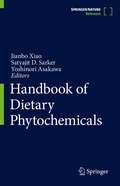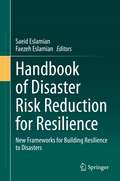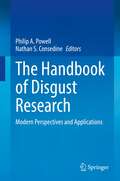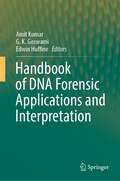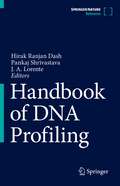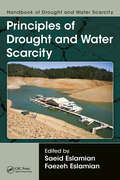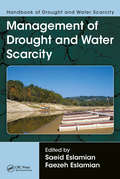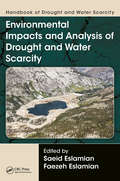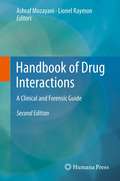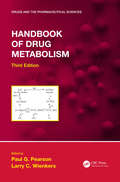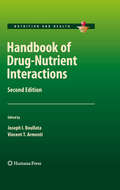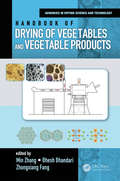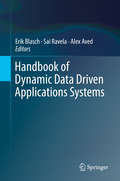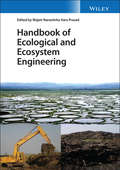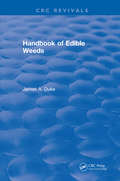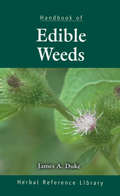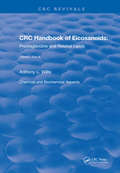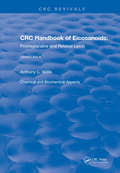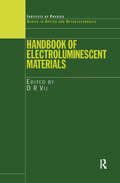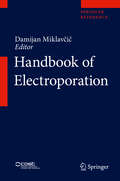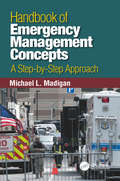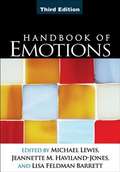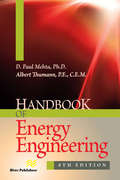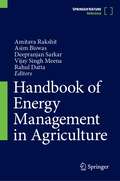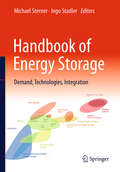- Table View
- List View
Handbook of Dietary Phytochemicals
by Jianbo Xiao Satyajit D. Sarker Yoshinori AsakawaThis book summarizes recent advances in the chemistry, bioactivity, nutrition, and functional aspects of dietary phytochemicals, as well as the health and functional aspects of foods rich in phytochemicals. Consisting of forty-four chapters, it discusses the different chemical types of phytochemicals in our diets and food and presents data collected from animal or human experiments that are directly related to human health. Each chapter covers the chemistry, epidemiological study, bioavailability, bioactivity (animal experiments) function in humans and safety, as well as products on the market. Moreover, the more than 200 figures make it easy to grasp the main findings in each area.
Handbook of Disaster Risk Reduction for Resilience: New Frameworks for Building Resilience to Disasters
by Saeid Eslamian Faezeh EslamianThis book is part of a six-volume series on Disaster Risk Reduction and Resilience. The series aims to fill in gaps in theory and practice in the Sendai Framework, and provides additional resources, methodologies and communication strategies to enhance the plan for action and targets proposed by the Sendai Framework. The series will appeal to a broad range of researchers, academics, students, policy makers and practitioners in engineering, environmental science and geography, geoscience, emergency management, finance, community adaptation, atmospheric science and information technology. This volume discusses how to measure and build disaster resilience at society’s capacity, drawing upon individual, institutional and collective resources to cope with and adapt to the demands and challenges of natural disaster occurrences. The book will serve as a guide, outlining the key indicators of disaster resilience in urban and rural settings, and the resources and strategies needed to build resilient communities in accordance with the targets of the Sendai Framework. Readers will learn about multi-risk reduction approaches using computational methods, data mining techniques, and System Thinking at various scales, as well as institutional and infrastructure resilience strategies based on several case studies.
The Handbook of Disgust Research: Modern Perspectives and Applications
by Philip A. Powell Nathan S. ConsedineThis volume brings together the world's leading experts on disgust to fully explore this understudied behavior. Disgust is unique among emotions. It is, at once, perhaps the most “basic” and visceral of feelings while also being profoundly shaped by learning and culture. Evident from the earliest months of life, disgust influences individual behavior and shapes societies across political, social, economic, legal, ecological, and health contexts. As an emotion that evolved to prevent our eating contaminated foods, disgust is now known to motivate wider behaviors, social processes, and customs. On a global scale, disgust finds a place in population health initiatives, from hand hygiene to tobacco warning labels, and may underlie aversions to globalization and other progressive agendas, such as those regarding sustainable consumption and gay marriage.This comprehensive work provides cutting‐edge, timely, and succinct theoretical and empirical contributions illustrating the breadth, rigor, relevance, and increasing maturity of disgust research to modern life. It is relevant to a wide range of psychological research and is particularly important to behavior viewed through an evolutionary lens, As such, it will stimulate further research and clinical applications that allow for a broader conceptualization of human behavior.The reader will find:Succinct and accessible summaries of key perspectivesHighlights of new scientific developmentsA rich blend of theoretical and empirical chapters
Handbook of DNA Forensic Applications and Interpretation
by Amit Kumar G. K. Goswami Edwin HuffineThis handbook covers tested and proven DNA forensic testing methodologies, forensic bioinformatics techniques, case studies and current forensic legal framework for investigation of variety of crimes and provides a clinching evidence for speedy justice. DNA testing is widely used for forensic purposes and is changing the paradigm of (crime) investigation. The book contains chapters on usage of ultramodern DNA collection kits, presents era evidence collection and preservation, high-end DNA sample analysis in laboratory, DNA legislation, expert evidences, challenging and successful case studies, data generation and application of AI and IoT techniques for DNA data analysis, DNA databanks and training manpower to facilitate timely reporting to the requesting agencies. This handbook equips and enables police, investigators and crime analysis laboratories with knowhow of high-end tools, procedures and techniques to link or exclude a criminal to a crime. It is expected that this will be used by first responders, police, forensic analysts, judiciaries, evidence handlers and students and scholars of criminology and forensic sciences worldwide. The intention to write this handbook is to make DNA technology and its importance reach every common man and professional for correctly using it as a tool as and when required. This is quite evident that awareness of DNA technology has increased at a reasonable pace. Courts and investigating agencies are convinced and confident with its accuracy, reliability and unmatched peace delivered by various techniques of DNA fingerprinting and DNA profiling.
Handbook of DNA Profiling
by Hirak Ranjan Dash Pankaj Shrivastava J. A. LorenteThis reference book comprehensively reviews the significance of DNA technology in forensic science. After presenting the theory, basic principles, tools and techniques that are used in forensic DNA typing, it summarizes various techniques, including autosomal STR, Y-STR, X-STR, mitochondrial DNA and NGS, used in solving both criminal as and civil cases, such as paternity disputes, identification of mutilated remains, and culprit identification in sexual assault and murder cases. It also provides an overview of DNA-based genetic diagnostics for various diseases, and discusses the role of DNA typing in drug reactions, as well as the application of non-human DNA profiling of animals and plants in forensic science investigations. Lastly, the book examines the role of internal quality control in maintaining the high quality of DNA profiling.
Handbook of Drought and Water Scarcity: Principles of Drought and Water Scarcity
by Saeid Eslamian Faezeh A. EslamianThis volume include over 30 chapters, written by experts from around the world. It examines drought and all of the fundamental principles relating to drought and water scarcity. It includes coverage of the causes of drought, occurences, preparations, drought vulnerability assessments, societal implications, and more.
Handbook of Drought and Water Scarcity: Management of Drought and Water Scarcity
by Saeid Eslamian Faezeh A. EslamianThis volume includes over 30 chapters, written by experts from around the world. It examines numerous management strategies for dealing with drought and scarcity. These strategies include management approaches for different regions, such as coastal, urban, rural, and agricultural areas. It offers multiple strategies for monitoring, assessing, and forcasting drought through the use of remote sensing and GIS tools. It also presents drought mitigation management strategies, such as groundwater management, rainwater harvesting, conservations practices, and more.
Handbook of Drought and Water Scarcity: Environmental Impacts and Analysis of Drought and Water Scarcity
by Saeid Eslamian Faezeh A. EslamianThis volume includes over 30 chapters, written by experts from around the world. It examines the environmental aspects of drought such as groundwater and soil contamination, river low-flow, urban water quality, and desertification. It also examines the effects of climate change and variability on drought, and discusses the differences in groundwater, rainfall, and temperatures and their related effects. It presents analytical modeling for better understanding drought in uncertain and changing climates.
Handbook of Drug Interactions
by Lionel Raymon Ashraf MozayaniAdverse drug reactions and interactions are still a major headache for healthcare professionals around the world. The US Food and Drug Administration's database recorded almost 300,000 serious adverse events in 2009 alone, of which 45,000 instances proved fatal. This updated new edition of the indispensable guide to drug interactions incorporates fresh research completed since the book's original publication by Humana Press in 2004. Additions include a new section on pharmacogenomics, a rapidly growing field that explores the genetic basis for the variability of responses to drugs. This new material reviews important polymorphisms in drug metabolizing enzymes and applies the findings to forensic interpretation, using case studies involving opiates as exemplars. Existing chapters from the first edition have in most cases been updated and reworked to reflect new data or incorporate better tables and diagrams, as well as to include recent drugs and formulations. Recent references have been inserted too. The handbook features extra material on illicit drug use, with a new chapter tackling the subject that covers cocaine, amphetamines and cannabis, among others. The section on the central nervous system also deals with a number of drugs that are abused illicitly, such as benzodiazepines, opiates flunitrazepam and GHB, while so-called 'social' drugs such as alcohol and nicotine are still discussed in the book's section on environmental and social pharmacology. Focusing as before on detailed explanation and incorporating both pharmacokinetic and pharmacodynamic drug interactions, this book will continue to be a lodestar for health and forensic professionals as well as students.
Handbook of Drug Metabolism, Third Edition (ISSN #Vol. 186)
by Paul G. Pearson and Larry C. WienkersThis book continues to be the definitive reference on drug metabolism with an emphasis on new scientific and regulatory developments. It has been updated based on developments that have occurred in the last 5 years, with new chapters on large molecules disposition, stereo-selectivity in drug metabolism, drug transporters and metabolic activation of drugs. Some chapters have been prepared by new authors who have emerged as subject area experts in the decade that has passed since publication of the first edition.
Handbook of Drug-Nutrient Interactions
by Vincent T. Armenti Joseph I. BoullataHandbook of Drug-Nutrient Interactions, Second Edition is an essential new work that provides a scientific look behind many drug-nutrient interactions, examines their relevance, offers recommendations, and suggests research questions to be explored. In the five years since publication of the first edition of the Handbook of Drug-Nutrient Interactions new perspectives have emerged and new data have been generated on the subject matter. Providing both the scientific basis and clinical relevance with appropriate recommendations for many interactions, the topic of drug-nutrient interactions is significant for clinicians and researchers alike. For clinicians in particular, the book offers a guide for understanding, identifying or predicting, and ultimately preventing or managing drug-nutrient interactions to optimize patient care. Divided into six sections all chapters have been revised or are new to this edition. Chapters balance the most technical information with practical discussions and include outlines that reflect the content; discussion questions that can guide the reader to the critical areas covered in each chapter, complete definitions of terms with the abbreviation fully defined and consistent use of terms between chapters. The editors have performed an outstanding service to clinical pharmacology and pharmaco-nutrition by bringing together a multi-disciplinary group of authors. Handbook of Drug-Nutrient Interactions, Second Edition is a comprehensive up-to-date text for the total management of patients on drug and/or nutrition therapy but also an insight into the recent developments in drug-nutrition interactions which will act as a reliable reference for clinicians and students for many years to come.
Handbook of Drying of Vegetables and Vegetable Products (Advances in Drying Science and Technology)
by Min Zhang Bhesh Bhandari Zhongxiang FangThis handbook provides a comprehensive overview of the processes and technologies in drying of vegetables and vegetable products. The Handbook of Drying of Vegetables and Vegetable Products discusses various technologies such as hot airflow drying, freeze drying, solar drying, microwave drying, radio frequency drying, infrared radiation drying, ultrasound assisted drying, and smart drying. The book’s chapters are clustered around major themes including drying processes and technologies, drying of specific vegetable products, properties during vegetable drying, and modeling, measurements, packaging & safety. Specifically, the book covers drying of different parts and types of vegetables such as mushrooms and herbs; changes to the properties of pigments, nutrients, and texture during drying process; dried products storage; nondestructive measurement and monitoring of moisture and morphological changes during vegetable drying; novel packaging; and computational fluid dynamics.
Handbook of Dynamic Data Driven Applications Systems
by Erik Blasch Sai Ravela Alex AvedThe Handbook of Dynamic Data Driven Applications Systems establishes an authoritative reference of DDDAS, pioneered by Dr. Darema and the co-authors for researchers and practitioners developing DDDAS technologies.Beginning with general concepts and history of the paradigm, the text provides 32 chapters by leading experts in10 application areas to enable an accurate understanding, analysis, and control of complex systems; be they natural, engineered, or societal:Earth and Space Data AssimilationAircraft Systems ProcessingStructures Health MonitoringBiological Data AssessmentObject and Activity TrackingEmbedded Control and CoordinationEnergy-Aware OptimizationImage and Video ComputingSecurity and Policy CodingSystems Design The authors explain how DDDAS unifies the computational and instrumentation aspects of an application system, extends the notion of Smart Computing to span from the high-end to the real-time data acquisition and control, and manages Big Data exploitation with high-dimensional model coordination.
Handbook of Ecological and Ecosystem Engineering
by Majeti Narasimha Vara PrasadLearn from this integrated approach to the management and restoration of ecosystems edited by an international leader in the field The Handbook of Ecological and Ecosystem Engineering delivers a comprehensive overview of the latest research and practical developments in the rapidly evolving fields of ecological and ecosystem engineering. Beginning with an introduction to the theory and practice of ecological engineering and ecosystem services, the book addresses a wide variety of issues central to the restoration and remediation of ecological environments. The book contains fulsome analyses of the restoration, rehabilitation, conservation, sustainability, reconstruction, remediation, and reclamation of ecosystems using ecological engineering techniques. Case studies are used to highlight practical applications of the theory discussed within. The material in the Handbook of Ecological and Ecosystem Engineering is particularly relevant at a time when the human population is dramatically rising, and the exploitation of natural resources is putting increasing pressure on planetary ecosystems. The book demonstrates how modern scientific ecology can contribute to the greening of the environment through the inclusion of concrete examples of successful applied management. The book also includes: A thorough discussion of ecological engineering and ecosystem services theory and practice An exploration of ecological and ecosystem engineering economic and environmental revitalization An examination of the role of soil meso and macrofauna indicators for restoration assessment success in a rehabilitated mine site A treatment of the mitigation of urban environmental issues by applying ecological and ecosystem engineering A discussion of soil fertility restoration theory and practice Perfect for academic researchers, industry scientists, and environmental engineers working in the fields of ecological engineering, environmental science, and biotechnology, the Handbook of Ecological and Ecosystem Engineering also belongs on the bookshelves of environmental regulators and consultants, policy makers, and employees of non-governmental organizations working on sustainable development.
Handbook of Edible Weeds: Herbal Reference Library
by James A. Duke"If you can't beat it, eat it." Words of wisdom from the author of this portable guide that emphasizes finding practical uses for weeds rather than waging pesticidal war on them. CRC Handbook of Edible Weeds contains detailed descriptions and illustrations of 100 edible weeds, representing 100 genera of higher plant species. Some of the species are strictly American, but many are cosmopolitan weeds. Each account includes common names recognized by the Weed Science Society of America, standard Latin scientific names, uses, and distribution (geographic and ecological). Cautionary notes are included regarding the potential allergenic or other harmful properties of many of the weeds. CRC Handbook of Edible Weeds is an excellent volume for botanists, plant scientists, horticulturalists, herbalists, and others interested in the edibility and practical uses of weeds.
Handbook of Edible Weeds: Herbal Reference Library
by James A. DukeHandbook of Edible Weeds contains detailed descriptions and illustrations of 100 edible weeds, representing 100 genera of higher plant species. Some of the species are strictly American, but many are cosmopolitan weeds. Each account includes common names recognized by the Weed Science Society of America, standard Latin scientific names, uses, and distribution (geographic and ecological). Cautionary notes are included regarding the potential allergenic or other harmful properties of many of the weeds.
Handbook of Eicosanoids: Volume I, Part B (CRC Press Revivals)
by A. L. WillisBuilding upon the extensive compilation of biochemical data featured in Volume I of the Handbook of Eicosanoids, the new Volume II describes the past, present, and potential future impact of eicosanoid research on new drug development. The reader is taken from a historical perspective through state-of-the-art basic concepts to extensive tabulation of molecular structures of compounds known to act via the eicosanoid system. Much emphasis is given to recent breakthroughs in the mechanism of action of anti-inflammatory corticosteroids and the development of receptor antagonists for prostaglandins and leukotrienes. There is also an introductory chapter that proposes areas that require further investigation and novel approaches using existing technology. This handbook will thus be invaluable for medicinal chemists, pharmacologists, and all those involved in basic research in the eicosanoid area. In addition, many parts of this handbook are suitable for use by university lecturers and students. There are 20 figures and 44 extensive tables as well as a bibliography containing more than 2,000 references that complement the text.
Handbook of Eicosanoids: Volume I, Part A (CRC Press Revivals)
by A. L. WillisBuilding upon the extensive compilation of biochemical data featured in Volume I of the Handbook of Eicosanoids, the new Volume II describes the past, present, and potential future impact of eicosanoid research on new drug development. The reader is taken from a historical perspective through state-of-the-art basic concepts to extensive tabulation of molecular structures of compounds known to act via the eicosanoid system. Much emphasis is given to recent breakthroughs in the mechanism of action of anti-inflammatory corticosteroids and the development of receptor antagonists for prostaglandins and leukotrienes. There is also an introductory chapter that proposes areas that require further investigation and novel approaches using existing technology. This handbook will thus be invaluable for medicinal chemists, pharmacologists, and all those involved in basic research in the eicosanoid area. In addition, many parts of this handbook are suitable for use by university lecturers and students. There are 20 figures and 44 extensive tables as well as a bibliography containing more than 2,000 references that complement the text.
Handbook of Electroluminescent Materials (Series in Optics and Optoelectronics)
by D. R. VijAn electroluminescent (EL) material is one that emits electromagnetic (EM) radiation in the visible or near visible range when an electric field is applied to it. EL materials have a vast array of applications in the illumination and displays industries, from cheap and energy efficient lighting to large high resolution flat panel displays.
Handbook of Electroporation
by Damijan MiklavčičThis major reference work is a one-shot knowledge base on electroporation and the use of pulsed electric fields of high intensity and their use in biology, medicine, biotechnology, and food and environmental technologies. The Handbook offers a widespread and well-structured compilation of 156 chapters ranging from the foundations to applications in industry and hospital. It is edited and written by most prominent researchers in the field. With regular updates and growing in its volume it is suitable for academic readers and researchers regardless of their disciplinary expertise, and will also be accessible to students and serious general readers. The Handbook's 276 authors have established scholarly credentials and come from a wide range of disciplines. This is crucially important in a highly interdisciplinary field of electroporation and the use of pulsed electric fields of high intensity and its applications in different fields from medicine, biology, food processing, agriculture, process engineering, energy and environment. An Editorial Board of distinguished scholars from across the world has selected and reviewed the various chapters to ensure the highest quality of this Handbook.The book was edited by an international team of Section Editors: P. Thomas Vernier, Boris Rubinsky, Juergen Kolb, Damijan Miklavcic, Marie-Pierre Rols, Javier Raso, Richard Heller, Gregor Serša, Dietrich Knorr, and Eugene Vorobiev.
Handbook of Emergency Management Concepts: A Step-by-Step Approach
by Michael L. MadiganThis book provides a step-by-step process that focuses on how to develop, practice, and maintain emergency plans that reflect what must be done before, during, and after a disaster, in order to protect people and property. The communities who preplan and mitigate prior to any incident will be better prepared for emergency scenarios. This book will assist those with the tools to address all phases of emergency management. It covers everything from the social and environmental processes that generate hazards, to vulnerability analysis, hazard mitigation, emergency response, and disaster recovery.
Handbook of Emotions, Third Edition
by Michael Lewis Jeannette Haviland-JonesWidely regarded as the standard reference in the field, this handbook comprehensively examines all aspects of emotion and its role in human behavior. The editors and contributors are foremost authorities who describe major theories, findings, methods, and applications. The volume addresses the interface of emotional processes with biology, child development, social behavior, personality, cognition, and physical and mental health. Also presented are state-of-the-science perspectives on fear, anger, shame, disgust, positive emotions, sadness, and other distinct emotions. Illustrations include seven color plates.
Handbook of Energy Engineering (Energy Engineering and Systems)
by D. Paul Mehta Albert ThumannWith new chapters on electrical system optimization and ISO 50001, this edition also covers the latest updates to codes and standards in the energy industry. Also included are chapters on energy economic analysis, energy auditing, waste heat recovery, utility system optimization, HVAC, cogeneration, control systems, energy management, compressed air system optimization and financing energy projects. Additional topics include emerging technologies such as oxy-fuel combustion, high efficiency burners, enhanced heat exchangers, and ceramic membranes for heat recovery as well as information on how to do an energy analysis of any system; electrical system optimization; state-of-the-art lighting and lighting controls. This reference will guide you step by step in applying the principles of energy engineering and management to the design of electrical, HVAC, utility, process and building systems for both new design and retrofit projects. The text is thoroughly illustrated with tables, graphs, diagrams and sample problems.
Handbook of Energy Management in Agriculture
by Amitava Rakshit Asim Biswas Deepranjan Sarkar Vijay Singh Meena Rahul DattaThis handbook provides a holistic overview of different aspects of energy management in agriculture with an orientation to address the sustainable development goals. It covers possible applications not only from a technical point of view, but also from economic, financial, social, regulatory, and political viewpoints. Agriculture is one of the most imperative sectors that contribute to the economy across different agro-ecologies of the universe with energy inputs in each stage of production, from making and applying chemicals to fueling tractors that lay seeds and harvest crops to electricity for animal housing facilities. The majority of agricultural research has focused on the use of input, production, and productivity, whereas rational energy budgeting and use remain an overlooked and likely underestimated segment, ignored so far while formulating agro-ecosystem framework. Energy management study is a new frontier of agriculture and is challenging duе to complex enterprises, spatial-temporal variability, exposure to pollution, and the predominant effect of the anthropogenic factor on ecology and environment. But it is worth taking the challenge considering the important prerequisite role of energy for sustainable development which has been evidenced from increasing research in recent times. Of recent origin, there are critical, in-depth studies around the globe assessing the capture and flow of energy in the ecosystem, which will help to develop a conceptual framework to incorporate this vital resource in the agriculture management template. This book is a state-of-the-art resource for a broad group of readers including a diversity of stakeholders and professionals in universities, public energy institutions, farmers and farming industry, public health and other relevant institutions, and the broader public as well.
Handbook of Energy Storage: Demand, Technologies, Integration
by Michael Sterner Ingo StadlerThe authors of this Handbook offer a comprehensive overview of the various aspects of energy storage. After explaining the importance and role of energy storage, they discuss the need for energy storage solutions with regard to providing electrical power, heat and fuel in light of the Energy Transition. The book’s main section presents various storage technologies in detail and weighs their respective advantages and disadvantages. Sections on sample practical applications and the integration of storage solutions across all energy sectors round out the book. A wealth of graphics and examples illustrate the broad field of energy storage, and are also available online. The book is based on the 2nd edition of the very successful German book Energiespeicher. It features a new chapter on legal considerations, new studies on storage needs, addresses Power-to-X for the chemical industry, new Liquid Organic Hydrogen Carriers (LOHC) and potential-energy storage, and highlights the latest cost trends and battery applications. “Finally – a comprehensive book on the Energy Transition that is written in a style accessible to and inspiring for non-experts.” Franz Alt, journalist and book author “I can recommend this outstanding book to anyone who is truly interested in the future of our country. It strikingly shows: it won’t be easy, but we can do it.” Prof. Dr. Harald Lesch, physicist and television host
